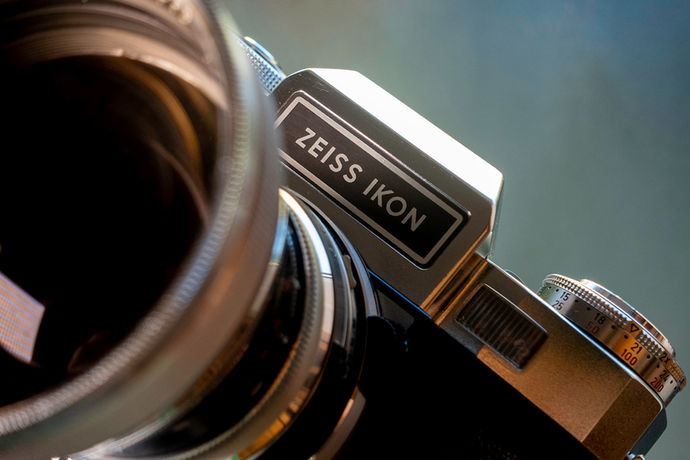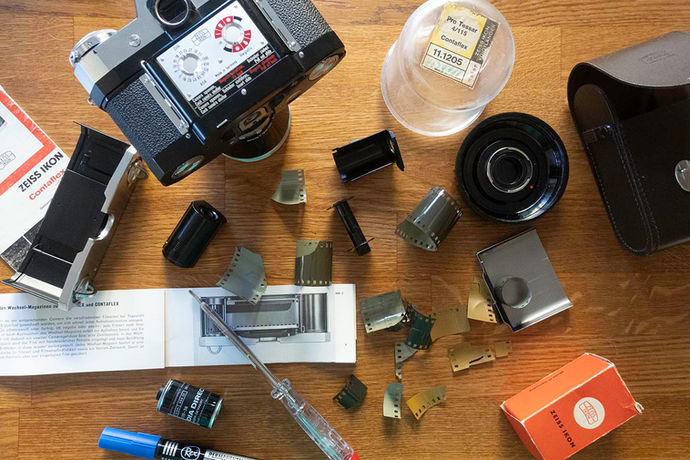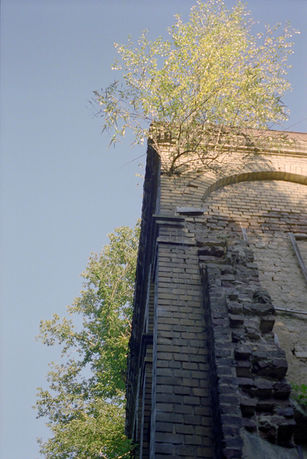
Contaflex Super BC
This camera was introduced in 1965 as a development of the Contaflex series. And the data from the camera was a bit of a sensation.
Like its predecessor, the Contaflex Super B, the Super BC had an automatic flash and automatic aperture control with time preselection.
What was new, however, was the exposure measurement, which was carried out via a CdS (cadmium sulfite) cell through the taking lens ("TTL" - through the lens).
This measurement through the lens was the real sensation!
This automatic and measurement was possible with all offered lenses.

Contaflex Super BC
Year of construction: 1965-1971
Format: for 35mm film (24x36)
Lenses: Set of lenses from Carl Zeiss Oberkochen.
Tessar 2.8 / 50mm
Pro-Tessar 3.2 / 35mm
Pro-Tessar 4 / 115mm
Older invoices:
Pro-Tessar 4 / 35mm
Pro-Tessar 4 / 85mm
Apertures: 2.8 to 22
Shutter: Central shutter, permanently installed in the camera, the optical system of the shutter is part of the optical calculations of the available set of lens attachments
Shutter speeds: 1; 1/2; 1/4; 1/8; 1/15; 1/30; 1/60; 1/125; 1/250; 1/500 sec. + Bulb
Hot shoe and connection for wireless icon flashes
Exposure meter: CdS exposure system with automatic aperture (can be switched off). No tracking measurement in manual mode
Battery: PX 625 mercury 1.35 volts (no longer available, see text on the right)
The battery is only required for exposure metering, otherwise the camera works fully mechanically.
Film counter: yes, resettable
(counting down in the elevator button)
Viewfinder: Roof-edge SLR viewfinder No viewfinder image after taking the picture before the shutter is cocked again!
Film advance: quick advance lever
Rangefinder: yes, cross-section and fine grid ring
Self-timer: yes
Film sensitivities: DIN 12-27 /
ISO-ASA 12 to 400
Additional:
Tripod thread, eyepiece lock, interchangeable cassettes for films

Contaflex Super BC
TTL metering offers and offered several advantages, as extension factors of shooting accessories such as filters and extension rings are automatically taken into account.
The light meter requires a 1.35V mercury battery of the type PX625, which has not been allowed to be produced or imported in Europe and North America for several years. If you consult the Internet, you will certainly find a source for these batteries in Russia. WARNING! Importing them is forbidden by law and can be punished...
If you don't want to act illegally, set the light meter to a voltage of 1.5 volts and use commercially available silver oxide SR44 or alkaline batteries. There are also zinc-air batteries, which also supply almost 1.35 (1.4), but lose energy continuously after activation and are used up after about 6 months even when not in use.
In general, the light meter and thus also the power consumption of the entire camera is switched off by setting the central shutter from "A" to any aperture value.

Contafelex Super BC
About 17,475 copies of this model were made. In the picture below you can see the set lens Pro Tessar 4 / 115mm attached to the camera.
The lenses do not have their own worm gear, the focus is adjusted with the help of two levers on the camera that enlarge or reduce the focus and thus bring the subject into focus.
The set distance can be read off and transferred to a ring on the lens attachments. In this way, the depth of field can be read depending on the aperture selected.
I can only say about the lens attachments:
A dream made of glass, lots of glass and metal!

Here is a small picture gallery with the main motif of the Contaflex Super BC and various accessories.
In my opinion, anyone who can live with the limited range of focal lengths will get a great 35mm SLR system.
The possibility of using removable film cassettes is almost unique. So you can use different films depending on the motif or lighting conditions, whether C41, B&W films, 100 ISO-ASA / 21DIN or 3200 ISO-ASA / 36 DIN and change them whenever you want, without losing even a piece of film material !
Contaflex Super BC - built-in eyepiece lock
Ikoblitz 6 is triggered - in slow motion
Self-timer and central locking do their job
A picture gallery with a description
 Ein Blick durch den Sucher einer Contaflex Super BC. |  Rechts sind die Blenden und Verschlußzeiten abzulesen. Die Verschlußzeit wird vorgewählt, die Blende ermittelt der eingebaute CDS-Belichtungsmesser (TTL-Messung). The apertures and shutter speeds can be read on the right. The shutter speed is preselected, the aperture is determined by the built-in CDS light meter (TTL metering). |  Ikoblitz in verschiedenen Ausführungen. Ikoblitz in various designs. |
|---|---|---|
 Verwendet werden können z.B. Blitzlichtbirnen vom Typ XM 1/5/6 (Fa. Osram), Philips AG3 (mit Splitterschutz) und Philips PF1. Ein "B" in der Bezeichnung steht für die Verwendung mit Tageslichtfarbfilm. |  The following can be used, for example Flash bulbs of type XM 1/5/6 (Osram), Philips AG3 (with splinter protection) and Philips PF1. A "B" in the designation stands for use with daylight color film. |  Batteriefach - klicke für mehr Informationen! Battery tray - klick for more informations! |
 Okularverschluß Eye piece lock |  Belichtungsmesser - klicke für mehr Informationen Light meter - klick for more informations! |  Belichtungsmesser - klicke für mehr Informationen Light meter - klick for more informations! |
 X-Kontakt für Blitzgeräte contact for flashes |  |  Nahlinse von Carl Zeiss Close-up lens by Carl Zeiss |
The following pictures are with the Zeiss Ikon Contaflex Super BC and the lenses
Pro Tessar 4/35, 3.2 / 35, 2.8 / 50, 4/85 and 4/115 were made.
From a quality point of view, you can use any lens without hesitation - the results will convince and satisfy you!
Instructions for you to download can be found here!
Voigtländer Bessamatic and lenses for the Kodak Retina Reflex
I like to shoot with my Voigtländer Bessamatic cameras. I also often adapt their lenses to my Sony A7III, especially the Septon 2/50mm.
Unfortunately Voigtländer only offered the 35mm focal length as their most powerful wide angle.
Not so Kodak for its Retina Reflex, here there was an Eurygon 2.8/30mm from Rodenstock or a Curtagon 4/28mm from Schneider-Kreuznach.
Both camera systems (and other manufacturers) used the Compur bayonet developed by the German company Deckel from Munich, the so-called "Deutsche Einheitsbajonett" - DKL.
Unfortunately it is not possible to use different lenses on different systems. The manufacturers have built in small changes on the camera side that do not allow an exchange of lenses between systems due to the design.
To be able to use Kodak Retina Relfex lenses on Voigtländer Bessamatic cameras, a small surgical operation on the bayonet is necessary, which you can see in the video. A small piece of metal has to be cut off the bayonet by milling.
My son Julian performed the operation...it's really quite simple - take heart and enjoy a variety of new lenses on your Voigtländer Bessamatic!!!!!
version)
Here is the video in German:
Here you can see this video in english:
Here you can see where the notch has to be milled. In my experience, it doesn't depend on the millimeter!

































































